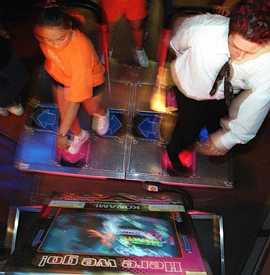|
|










































|
|
|

 

Dancing at the arcade
Popular video game
on the move in Arizona

|
Jeff Davids/The
Arizona Republic
|
Patty Marrese, 14, and Adam Ali, 18, follow their
virtual partner at Dance Dance Revolution at
Gameworks.
|
By Penny Walker
The
Arizona Republic
May 19, 2001
12:00:00
Anurag Gulati started putting on weight last fall, capping out at
225 pounds.
Then the senior at Corona del Sol High School discovered a
new arcade game, Dance Dance Revolution, at GameWorks at Arizona
Mills and began dancing on the game's platform for an hour a day. He
lost 30 pounds in four months.
Kind of like karaoke, only with dancing instead of singing,
Dance Dance Revolution requires only a basic rhythm and the
willingness to dance in front of a crowd. Judging by numerous Web
sites dedicated to the game, extensive DDR message boards and lines
of people waiting to play at arcades on weekends, DDR is attracting
a following throughout the country.
One or two players stand on a platform aglow in pink neon
lights and step on four large arrows in time to the beat of a
variety of techno-pop songs. A video screen shows which arrow to
step on and when. Players get points for correct steps, and if they
score well enough they advance to the next song.
Pretty simple concept. Pretty addicting.
DDR, part of Konami's Bemani series of rhythm-based games, is
one machine that rarely stands empty at GameWorks, the arcade's
staff says. Easy enough for the casual player yet challenging for
veterans, it's a nice change from the usual arcade fare.
"The interface is so innovative," says Bill Bradley, Chandler
resident and founder of DDR'izona, a Web site (go.to/DDRizona) that
aims to help establish a DDR scene in the state.
"You look at regular video games, you have a joystick and a
number of buttons. But with Dance Dance Revolution, you have to get
up there and actually do something."
Local players say the combination of mental and physical
challenge draws many people to the game - young, old, male, female,
it doesn't seem to make much difference. Though the main age group
tends to be late 20s and younger, Gulati says he once played a
67-year-old woman from San Francisco who was an avid DDR fan.
"She kicked my butt," he says.
As for the local DDR scene, Gulati says it's nothing like
California, where DDR made its U.S. debut in March 1999. (It was
released in late 1998 in Japan.)
According to the Web site ddrfreak.com, there are 143 DDR
locations in California, by far the most in any state. In contrast,
Arizona, where DDR debuted in autumn 1999, has six locations.
A U.S. PlayStation version has recently been released;
versions for Japanese Dreamcast and PlayStation have been on the
market for a while. The home game costs about $60.
Many players perfect their moves on a home version of the
game but continue to play in public. Amy Parsons of Mesa owns the
imported Dreamcast version, but she says nothing can replace the
experience of playing at an arcade.
"You get a performance thrill when you're up there," says
Parsons, 25. "Even if you don't think anyone is watching you."
And that's what DDR is all about: showing off your moves.
Some players have done certain songs so often that they memorize the
steps, turn their backs to the video screen and dance face to face
with the crowd that often gathers.
Expert "freestylers" - players who care more about the style
of the movement than making sure to hit every arrow - spin around
the platform, using feet, hands, knees, even their heads to hit the
arrows, Bradley says. One fan Web site has a movies link, www.bemanix.com/movie.asp, showing examples of
such stylers competing in California, where tournaments are common.
Bradley thinks it's only a matter of time before Valley arcades
hosttournaments.
You don't have to be an expert styler to get started with
DDR. All you need is the ability to tap out the beat to a song - and
the willingness to look silly in front of others.
You may want to try different arcades, as each location
differs in crowds, lighting, noise and atmosphere. The DDR USA
version has fewer songs but can be more user-friendly for beginners.
Veterans tend to prefer the versions of 3rd, 4th and 5th mixes
imported from Japan.
Most players in Arizona are friendly and more than willing to
help newbies figure out the game, explaining different levels and
modes, such as hidden mode, in which the arrows disappear halfway up
the screen. Even the game itself is vocal, razzing players when too
many arrows are missed ("Did you have your breakfast today?") or
voicing compliments when things are going well ("Wow, you are too
cool.").
For those who aren't too willing to look that silly in
public, keep in mind the point is to enjoy the game. Once most
people get the courage to try, they're hooked.
"It didn't look like that much fun to me," Gulati says. "But
once you start playing, the fun factor is amazing."
Reach the reporter at penny.walker@arizonarepublic.com
or (602) 444-8014.
| |
|
|
|
 

Rep's Best
TV listings
Comics & Games
Web Watch
Horoscopes
Movies
Email
newsletters
Sign up to receive our free
weekly newsletter filled with health and fitness tips for ages 40+.
|


 Republic
Front Page | Valley
and State | Sports
Republic
Front Page | Valley
and State | Sports